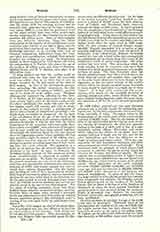

Worcester, Ancient Diocese of (WIGORNIENSIS), England, created in 680 when, at the Synod of Hatfield under St. Theodore, Archbishop of Canterbury, the great Mercian diocese was divided into five sees. Tatfrith, a monk of Whitby, was nominated first bishop, but he died before consecration, and Bosel, one of his fellow monks, was consecrated in his stead. The history of the diocese was singularly uneventful, and it was specially fortunate in the fact that it never was long vacant, as so many other sees frequently were. The line of its bishops from 680 to 1565 was unbroken. The Mercian kings were profuse in the endowments which they lavished on the cathedral church, which was originally dedicated to St. Peter but afterwards to Our Lady. It was originally served by secular canons, but in the tenth century St. Oswald replaced them by Benedictines. He also rebuilt the cathedral, finishing the work in 983, but in 1041 the Danes burned the city and ruined the cathedral, and it was reserved for another saint, St. Wulstan, to rebuild it (1084-89). This new building frequently suffered from fire (1113, 1180, 1202). In 1216 King John was buried there, between the shrines of the two Worcester saints, Oswald and Wulstan; and two years later the cathedral, once more restored, was consecrated at a great gathering at which the king and many prelates and nobles were present. At various times modifications were made in the structure, which gradually assumed the Early Gothic character it now bears. Probably the Worcester nave is among the earliest instances of English Gothic, dating from the later part of the twelfth century. The transepts are a mixture of Norman and Perpendicular work; the choir, Lady chapel, and east transepts are Early English (1224). The crypt alone remains of St. Wulstan’s work. The monastic buildings, of which only the cloister, chapter-house, and refectory remain, were on the south and west of the cathedral. From the time of Henry VII the see was filled by Italian prelates, who represented the king’s interests at Rome. Among these was the future Pope Clement VII. It was the special prerogative of the bishop to act as chaplain to the Archbishop of Canterbury, and thus to celebrate Mass at all assemblies of the clergy at which the primate was present. The following is the complete list of bishops:—
Bosel
Oftfor
St. Ecgwine
Wilfrith I
Mildred
Waermund
Tilhere
Heathured (Aethelred)
Denebeorht
Heahbeorht (Eadbert)
Ealhhun (Alwin)
Waerfrith
Aethelhun
Wilfrith II
Coenweald
St. Dunstan
St. Oswald
Ealdwulf
Wulfstan
Leofsige
Beorhtheah
Lyfing
Aelfric Puttoc
Lyfing (restored)
Ealdred
St. Wulfstan II
Samson
Theulf
Simon
John de Pageham
Alured
Roger
Baldwin
William de Narhale
Robert Fitz-Ralph
Henry de Soilli
John de Constantiis
Mauger
Walter de Grey
Silvester de Evesham
William de Blois
The diocese included the County of Worcester and part of Warwickshire, and being of no very great extent only one archdeaconry was necessary, under which all the parishes, 241 in number, were included. The arms of the see were argent ten torteaux.
EDWIN BURTON

